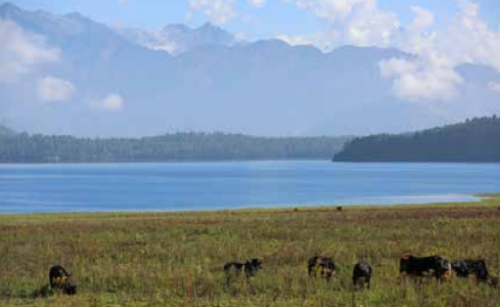
Nepal’s largest, pristine lake lacks infrastructure to lure would-be tourists
Raj Bahadur Rawal, 24, a peasant in the Mugu District of northwestern Nepal, purchased a horse six months ago, hoping to make a good income by serving tourists visiting Rara lake, the largest in Nepal. Now, however, he must sell it and find a job in India.
“The horse did cost 65,000 rupees (about 550 U.S. dollars), but up until now I have only earned 30,000 Rupees, which is not enough to support my family,” Rawal told Xinhua last week in a hotel, a stone’s throw away from the lake, adding that competition is fierce with too many available horses but only a few visitors.
Nestled among forests, which themselves are surrounded by snowcapped mountains, this pristine lake is considered to be one of the most beautiful places in Nepal. As far as foreign arrivals are concerned, however, this Arcadia looks deserted.
Devi Krishna Rokaya, Chairman of the Rara Tourism Development Committee, told Xinhua that foreigners traveling to Rara numbered around 300 last year. The number is negligible. According to Nepal Tourism Board, a main tourism promotional body of the Nepali government, the Himalayan country received a total of 940,218 foreign holiday-makers in 2017.
Foreigners, who travel here, one of the least developed districts, stand a good chance of getting into a jam, thanks to the poor air and road connectivity.
Five years ago at Talcha Airport, travelers recall waiting three days for a 30-minute air-hop to Nepalgunj, a city bordering India, from where travelers can easily reach the capital Kathmandu by air or by road. Of late, the situation has not improved. After spending nearly two days in the lake area last week, visitors to the region with air tickets reached Talcha Airport in the morning, only to find there was no flight to Nepalgunj available on the same day. The situation went from bad to worse since flights the next day and even the day after could not be confirmed.
To avoid wasting more time getting to Nepalgunj, they opted to hire a jeep and spend around 20 hours driving on the risky road full of bumps and hollows, which left them in pain and sullied what should have been an unforgettable journey.
Such poor service could easily make a foreigner traveler’s jaw drop. Local staffers are really hospital to foreigners, but the dining environment is disappointing.
In one small hotel, travelers reported finding a dead ant in the rice and a worm of some description crawling in the dish. A fly kicked off the proceedings by deciding to jump into what may well have been a delicious soup, they recalled.
There is other evidence that the pleasant scenery in this area is unprepared for foreign tourists- foreigners are not allowed to take a boat ride in the lake. Boating is the most popular activity at Nepal’s Lake Fewa, and the main attraction of Pokhara, one of the most famous tourism destinations in the country.
Narayan Rupakheti, Information Officer at the Department of National Parks and Wildlife Conservation, told Xinhua that the authority didn’t prohibit foreigners to boat in the past but later stopped the service, realizing that there were insufficient human resources and securityrelated facilities. When asked why so few foreigners visit Rara area, Hari Jung Shahi, Mayor of Chhayanath Rara Municipality in Mugu district, said that one reason is a lack of proper publicity and information sharing.
“Over 60 percent of the Nepali population is unaware of Rara lake and its beauty, many even do not know where it is located,” said Shahi, in a recent exclusive interview with Xinhua.
According to the mayor, his municipality is planning to organize a selfpromotion event in the capital of Kathmandu where they will showcase videos and documentaries that depict the amazing beauty of Rara Lake and various other attractions in the remote region.
(Published by The Kathmandu Post)


